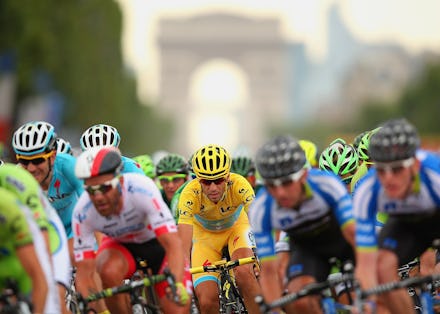The Science Behind What Separates Elite Endurance Athletes From Everyone Else

The Tour de France wrapped up this past Sunday with Vincenzo Nibali of Italy taking home the Maillot Jaune. As always, the Tour put the upper reaches of the human capacity for suffering on full display. Most notably to Americans, Andrew Talansky pushed through 117 miles of excruciating pain before abandoning the race. In an interview with ESPN.com's Bonnie D. Ford afterwards, Talansky said, "That day showed me when I need it, there's more in my body, more than I can do than even I can believe sometimes."
This begs the question: What about Talansky that makes him different? More broadly, what separates elite endurance athletes from the rest of us mere mortals?
There are several possible physiological advantages. One of the more essential is a superior cardiovascular system. Assuming proper nutrition, athletic endurance is, in simplest terms, limited by a human's ability to extract oxygen from the environment and deliver it to muscle cells that use it to generate energy.
There are a few limiters along the way that can limit oxygen delivery, and separate endurance athletes from others.
First, oxygen delivery can be limited by the heart's ability to pump blood (i.e. cardiac output). Miguel Indurain, five-time winner of the Tour de France, had a cardiac output of 50 liters per minute compared to a mere 25 L/min for the "average" fit male cyclist.
Second, it can be limited by the blood's ability to carry oxygen. This is why cycling has been plagued by drugs like erythropoietin (EPO), which boost red blood cell counts and enrich blood with more oxygen.
Finally, it can be limited by muscle cells' efficiency in absorbing oxygen from blood. As Tyler Hamilton explains in The Secret Race, Lance Armstrong began training and racing at a faster pedal rate (i.e. higher cadence) to minimize muscle exertion because, thanks to EPO, it was more likely his muscles would break down before his heart and lungs failed to deliver sufficient oxygen.
Exercise physiologists have traditionally measured cardiovascular ability using the VO2 max test, which measures the volume of oxygen a person can consume in one minute as he or she exercises at maximum exertion (it is adjusted for body weight as well). The test can be roughly thought of as a measure of horsepower for endurance. Greg LeMond, now technically the only American to have won the Tour de France, had a VO2 max of 92.5 ml/kg/min in his prime (Armstrong's was "only" 84). According to Runner's World, elite runners have scores ranging 65-85 ml/kg/min., whereas the average untrained male has a score of 35-30 ml/kg/min.
VO2 max scores certainly are not the be-all and end-all measure of fitness. Indeed, horsepower can be irrelevant if efficiency, or miles per gallon, is important. In a study published in the journal Applied Physiology, Nutrition, and Metabolism, researchers attribute "running economy," not aerobic capacity, to the success of East African runners. Researchers found no significant difference between the VO2 max values between Eritrean and Spanish runners. Instead, they found the East African runners used less oxygen to run the same distance as the Spanish runners.
Image Credit: Getty Images
The most fascinating and least understood differences between endurance superheroes and the rest of us may reside in their brains.
In The Sports Gene, David Epstein highlights two components of successfully coping with pain and suffering.
The first is a human's ability to perceive pain. A gene named SCN9A may, in some part, dictate this. Epstein points to a 2010 study that suggests that there is huge variation in how individuals perceive pain based on how the nervous system conducts those pain signals. As Epstein points out, "Genetic variation among individuals, it seems, ensures that none of us can truly know another's physical pain." A kilometer sprint can induce different levels of suffering for everyone, physiological fitness aside.
The second is the ability to process pain. Epstein highlights the work of David Goldman who has done research on a gene named COMT. Goldman suggests the gene plays a role in determining whether someone is a "worrier" or a "warrior." Warriors are more resilient to worriers under stress. Goldman estimates that, in the U.S., 16% of people are worriers, 36% are warriors, and the remaining 48% are somewhere in between.
The COMT gene does not entirely explain why an endurance athlete would be able to better cope with pain and suffering. But, it does point to the notion that some are better than others at processing the "emotion" of pain more effectively than others during endurance competition. Daniel Coyle, author of The Talent Code, once profiled ultra-endurance legend Jure Robic and noted that Robic was able to trick his brain into ignoring the pain. Robic is quoted as saying, "The pain doesn't exist for me. I know it is there because I feel it, but I don't pay attention to it."
Obviously, some pain should not be ignored: when you feel the kettle burning your skin, you should remove it. And while, we often idolize endurance legends, they also seem to uniquely prone to disaster. Sadly, Robic was one of these athletes. He died in a head-on collision with a car when he was cycling down a narrow mountain forest road.
Nevertheless, research on pain and the brain tells us that the Talansky story may be as much a tribute to his physiology as it is to his resilient mind. Even he, with all his training and physiological advantages, managed to find something "more" during the Tour. An elite endurance athlete must be able to convince him or herself that the pain is part of the victory. That suffering is just the body's way of telling the brain that it has achieved its goal of pushing its limits.